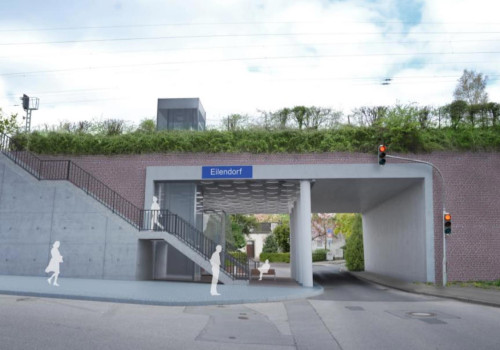Current station
Potential improvements
Background
Eilendorf station has very poor access – how should we improve it?
The problem: Getting from one platform to the other involves a long walk via the bridge to the west or the tunnel to the east. It is not unknown for passengers to be seen crossing the railway itself, despite the dangers posed by the unannounced freight and high speed trains which regularly pass through. The access issue also poses problems for the location of any future ticket machines, cycle parking and other facilities. There is also a need to raise platforms to improve wheelchair access on to trains.
Finding solutions: Aachen’s City Council, transport authority and university worked together with European partners to involve the local community in planning improvements to the station. It is hoped that the revamp will also offer the chance to integrate the station better with the village and local park, and to make the station entrance more visible. An encouraging step towards making the station more welcoming was the colourful artwork painted at the station by local school children in 2015.
Find out more on the City of Aachen’s Eilendorf station webpage (in German).
Key facts
700 passengers use the station each working day
Trains run every 30 minutes
Direct services to Heerlen, Aachen, Duren
The long walk:
360 metres platform-to-platform via bridge
340 metres platform-to-platform via tunnel
What’s happening?

In 2013, a feasibility study examined four options to improve access at the station: a new bridge, adapting the existing bridge, a new tunnel, and adapting the existing tunnel.

Community forums held as part of Citizens’ Rail gave local residents the chance to have their say and suggest ideas.

Students from France, the Netherlands, the UK and Germany visited Eilendorf as part of an international masterclass and created their own visions for improvements to the station.
More

Young people have helped to make the station more welcoming. They designed and painted a new look for shelters and the station’s noise-reduction wall. Find out more.
Plan

The verdict of the local community, project partners and the feasibility study will shape the future direction for improvements to the station.


















